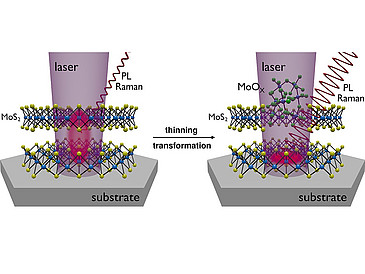Christian Tessarek, Oleg Gridenco, Martin Wiesing, Jan Müssener, Stephan Figge, Kathrin Sebald, Jürgen Gutowski, Martin Eickhoff
ACS Applied Nano Materials (2020) 3, 7490-7498
http://doi.org/10.1021/acsanm.0c01104
Laser-thinning of 2D materials such as MoS2 is a promising approach for a local reduction of the number of multilayers down to a monolayer. For a precise control of the thinning process real-time monitoring is required. In this work, short-wavelength lasers emitting at 325 or 406 nm respectively are used for laser-thinning and simultaneous Raman or photoluminescence spectroscopy of MoS2. The time evolution of the Raman and photoluminescence bands during the process shows a layer-by-layer thinning of MoS2 and a transformation into amorphous MoOx in an oxygen-containing atmosphere. In addition to the E2g1 and A1g Raman modes, the E1g, B2g1, and second-order modes are analyzed by using the 325 nm laser for excitation to achieve a more accurate determination of the number of layers. As a promising alternative, photoluminescence spectroscopy is used to monitor the thinning progress by analysis of the emission energy and intensity of the direct as well as the indirect band gap transition. Atomic force microscopy measurements show an increased total height of the laser-treated region after thinning of MoS2 due to the presence of transformed MoOx. Local micropatterning of a bilayer is also demonstrated by laser-thinning down to a monolayer at selected positions. The results show a new monitoring approach for controlled fabrication of 2D monolayers.


